How To Find Infinite Discontinuity
$$ \definecolor{importantColor}{RGB}{255,0,0} \definecolor{secondaryColor}{RGB}{255,0,255} $$
Quick Overview
- Discontinuities can be classified every bit jump, infinite, removable, endpoint, or mixed.
- Removable discontinuities are characterized past the fact that the limit exists.
- Removable discontinuities can exist "fixed" by re-defining the function.
- The other types of discontinuities are characterized by the fact that the limit does not exist. Specifically,
- Jump Discontinuities: both one-sided limits be, just have different values.
- Infinite Discontinuities: both ane-sided limits are infinite.
- Endpoint Discontinuities: just one of the 1-sided limits exists.
- Mixed: at to the lowest degree 1 of the i-sided limits does not exist.
Jump Discontinuities
The graph of $$f(x)$$ below shows a office that is discontinuous at $$ten = a$$.
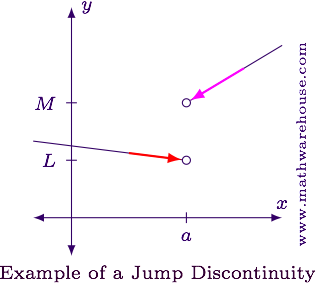
In this graph, you can easily see that $$ {\color{importantColor}\lim\limits_{x\to a^-} f(x) = L} % \mbox{ and } % {\colour{secondaryColor}\lim\limits_{x\to a^+} f(x) = M}. $$
The function is approaching unlike values depending on the direction $$x$$ is coming from. When this happens, we say the office has a leap discontinuity at $$x=a$$.
Infinite Discontinuities
The graph beneath shows a function that is discontinuous at $$x=a$$.
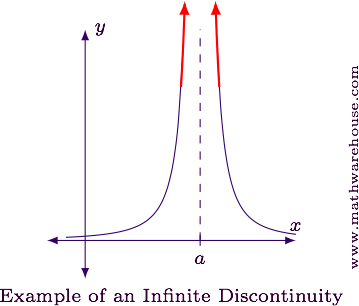
The arrows on the function indicate it will abound infinitely large every bit $$x$$ approaches $$a$$. Since the function doesn't approach a item finite value, the limit does not exist. This is an infinite discontinuity.
The following two graphs are also examples of infinite discontinuities at $$x = a$$. Notice that in all 3 cases, both of the one-sided limits are infinite.
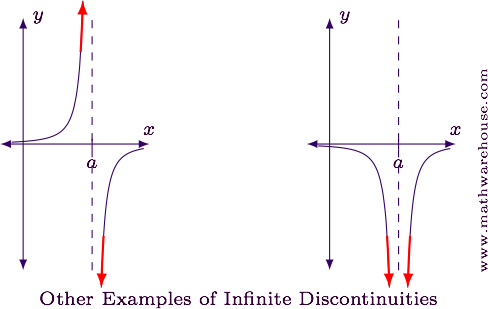
Removable Discontinuities
In the graphs below, there is a pigsty in the role at $$x=a$$. These holes are called removable discontinuities
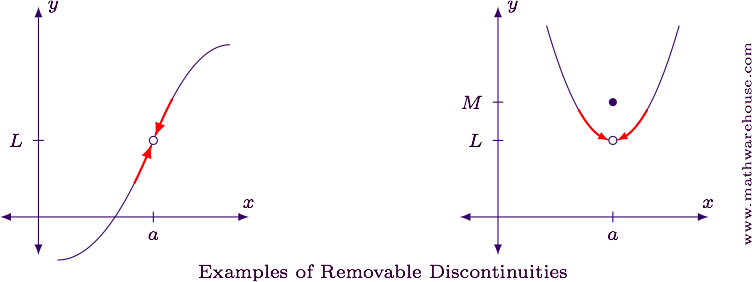
Notice that for both graphs, even though there are holes at $$10 = a$$, the limit value at $$x=a$$ exists.
Removable Discontinuities tin be Fixed
Removable discontinuities can be fixed past redefining the function, equally shown in the following example.
Example
The office beneath has a removable discontinuity at $$x = 2$$. Redefine the function and then that it becomes continuous at $$ten=ii$$.
$$f(x) = \frac{ten^2-2x}{x^2-4}$$
Solution
The graph of the function is shown below for reference.
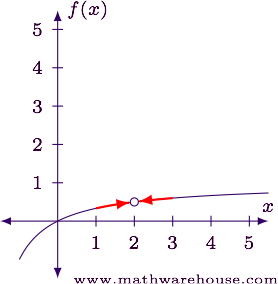
In social club to set up the discontinuity, we demand to know the $$y$$-value of the hole in the graph. To determine this, we notice the value of $$\lim\limits_{x\to ii} f(10)$$.
Examining the form of the limit we see
$$\displaystyle\lim_{ten\to 2} \frac{x^2-2x}{x^2-four} = \frac{(ii)^two - 2(ii)}{(2)^2-4} = \frac 0 0$$
The segmentation by null in the $$\frac 0 0$$ form tells us at that place is definitely a discontinuity at this point.
Adjacent, using the techniques covered in previous lessons (encounter Indeterminate Limits---Factorable) we tin can easily determine
$$\displaystyle\lim_{ten\to 2} f(ten) = \frac 1 ii$$
The limit value is also the $$y$$-value of the pigsty in the graph. Now we can redefine the original function in a piecewise form:
$$ \\ f(x) = \left\{% \begin{array}{ll} \frac{10^2-2x}{x^2-4}, & \mbox{for all } x \neq 2\\[6pt] % \frac ane 2, & \mbox{for } ten = 2 \finish{array} \right. \\ $$
The offset piece preserves the overall behavior of the role, while the second piece plugs the pigsty.
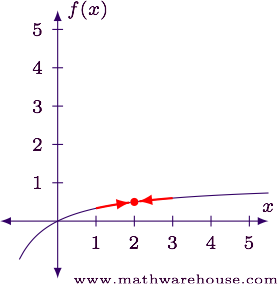
Endpoint Discontinuities
When a function is defined on an interval with a closed endpoint, the limit cannot exist at that endpoint. This is because the limit has to examine the function values as $$x$$ approaches from both sides.
For case, consider finding $$\displaystyle\lim\limits_{x\to0} \sqrt 10$$ (see the graph beneath).
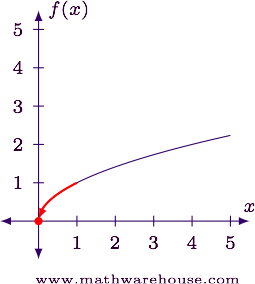
Note that $$x=0$$ is the left-endpoint of the functions domain: $$[0,\infty)$$, and the function is technically not continuous there because the limit doesn't exist (because $$x$$ can't approach from both sides).
We should note that the function is correct-manus continuous at $$x=0$$ which is why we don't run across any jumps, or holes at the endpoint.
Mixed Discontinuities
Consider the graph shown beneath.
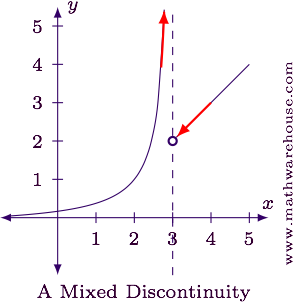
The function is obviously discontinuous at $$10 = 3$$. From the left, the function has an space aperture, but from the right, the aperture is removable. Since in that location is more one reason why the discontinuity exists, we say this is a mixed aperture

Fault : Delight Click on "Not a robot", then try downloading again.
How To Find Infinite Discontinuity,
Source: https://www.mathwarehouse.com/calculus/continuity/what-are-types-of-discontinuities.php
Posted by: glessnersopland.blogspot.com


0 Response to "How To Find Infinite Discontinuity"
Post a Comment